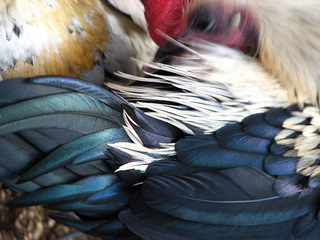Hydrogen Feathers
Air Date: Week of July 31, 2009

(Photo: *CA* )
Heated chicken feathers can efficiently store hydrogen without a huge price tag, say chemical engineers at the University of Delaware. Annie Glausser reports.
Transcript
YOUNG: Coming up – saying farewell to the green, green grass of home – But first this Cool Fix for a Hot Planet from Annie Glausser.
[SOUNDS OF CHICKENS]
GLAUSSER: Hydrogen fuel may have found a lucky wishbone. The key is to pluck a chicken.
Chemical engineers at the University of Delaware say toasted chicken feathers can outperform other hydrogen storage materials, and they do it at a fraction of the cost. Hydrogen—a potential green alternative to gasoline—is a finicky element, making it difficult to store and transport. As a liquid, it has to be kept at very low temperatures. As a pressurized gas, it takes up 30 times as much space as regular gasoline.
Using chicken feathers as a storage material allows hydrogen to be kept in a much smaller space. That’s because the feathers are made up of the protein keratin, which forms hollow strong tubes. When heated, the keratin tubes crosslink and strengthen, and at the same time become more porous. This dramatically increases its surface area, so it can absorb as much or more hydrogen than expensive carbon nanotubes or metal hydrides, two popular materials for storage.
The researchers estimate that a fuel tank made of chicken feathers would only carry a price tag of about $200 dollars, while a tank made of nanotubes or hydrides could be in the millions.
Our feathered friends may help ease us off fossil fuels but the science still needs some time to roost.
That’s this week’s Cool Fix for a Hot Planet. I’m Annie Glausser.
YOUNG: And if you have a Cool Fix for a Hot Planet, we'd like to know it.
If we use your idea on the air, we'll send you a shiny electric blue Living on Earth tire gauge. Keep your tires properly inflated and you could save hundreds of dollars a year in fuel. Email coolfix—that's one word coolfix—at loe.org. Once again, that's coolfix@loe.org.
Links
To learn more about the energy potential of chicken feathers, click here.
Living on Earth wants to hear from you!
Living on Earth
62 Calef Highway, Suite 212
Lee, NH 03861
Telephone: 617-287-4121
E-mail: comments@loe.org
Newsletter [Click here]
Donate to Living on Earth!
Living on Earth is an independent media program and relies entirely on contributions from listeners and institutions supporting public service. Please donate now to preserve an independent environmental voice.
NewsletterLiving on Earth offers a weekly delivery of the show's rundown to your mailbox. Sign up for our newsletter today!
 Sailors For The Sea: Be the change you want to sea.
Sailors For The Sea: Be the change you want to sea.
 The Grantham Foundation for the Protection of the Environment: Committed to protecting and improving the health of the global environment.
The Grantham Foundation for the Protection of the Environment: Committed to protecting and improving the health of the global environment.
 Contribute to Living on Earth and receive, as our gift to you, an archival print of one of Mark Seth Lender's extraordinary wildlife photographs. Follow the link to see Mark's current collection of photographs.
Contribute to Living on Earth and receive, as our gift to you, an archival print of one of Mark Seth Lender's extraordinary wildlife photographs. Follow the link to see Mark's current collection of photographs.
 Buy a signed copy of Mark Seth Lender's book Smeagull the Seagull & support Living on Earth
Buy a signed copy of Mark Seth Lender's book Smeagull the Seagull & support Living on Earth

